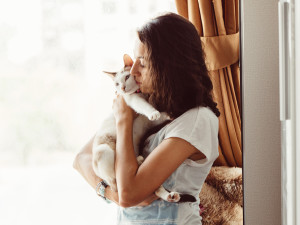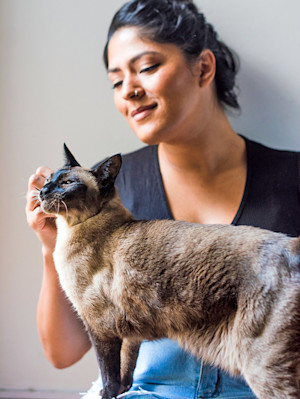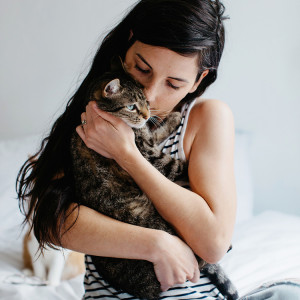Why Does Your Cat Knead Your Blanket and Purr?
They’re just cookin’ up some biscuits.

Share Article
In This Article:
Why Do Cats Make Biscuits on Blankets? Reasons Cats Knead and Purr Is It OK For Your Cat to Knead?
It has many different names: kneading, making muffins, making biscuits. I call it “the squishies” and actually hear “squish, squish, squish,” in my head when my cat does it. It’s that magical stretching, opening, and closing of a cat’s paws that usually happens on something soft and fluffy right before they curl up and fall asleep, generally accompanied by a big purr.
Kneading is one of those experiences that makes a lot of us wish we could be cats, if only for a few minutes. But why do they knead and purr? Is it always a sign of comfort? Should you let your cat knead anytime or anything they want? Let’s talk about it!

Why do cats knead on blankets and other soft things?
The biscuit-making machine known as feline kneading goes back to kittenhood. Nursing kittens instinctively use their paws to squish and squeeze their mom’s belly area. It helps stimulate milk flow. It’s pretty impressive that momma kitty can tolerate those razor-sharp kitten claws on her delicate skin.
Because nursing is such a peaceful, warm, comforting time for kittens, they tend to carry the same physical behavior (kneading) throughout their lives, like a security blanket.
Blankets, pillows, cushions, a pile of clean laundry, your dog, your belly… they will knead just about anything that has a little give. Some cats will even knead the air, or the ground they’re standing on. But blankets are probably the most common in the biscuit or muffin-making process.
Reasons cats knead and purr
Purring also tends to happen during nursing, meaning it has those same warm, fuzzy associations. That’s why it often accompanies kneading. But why are they doing all of this in the first place?
Here are some reasons your cat may be kneading and purring.
Feeling contentment
When adult cats knead and purr, they relive those comforting, cozy moments of nursing and snuggling with mom. Just like some people rub their feet together as a comforting way to signal it’s time to rest and reset in bed, cats do the same with kneading.
Getting comfy
This is what we think of when talking about cats kneading and purring. It even looks like they’re rearranging the blanket to make it as cozy as possible. You can see them working their way around the area, as if they’re trying to find the softest, most perfect spot. Then they plop down for a satisfying nap.
Looking for attention
Anything that gets your attention once becomes a logical way (if you’re a cat) to get that same attention again. For example, if you’re asleep and your cat would prefer you wake up, they may do a little kneading on your head. Why? Because the first time they did it, you woke up and said, “Hey, stop it.” It worked, so they innocently continued doing it.
Getting a good stretch
You’ve probably noticed your cat do some stretching with their kneading. They may give a few good squeezes and then do a big (ironically named) downward-facing dog pose to stretch those front legs and shoulders. A cobra stretch may come next, extending those back legs. It’s all in the name of muscle maintenance and probably feels great.
Self-soothing
Just as purring can be a sign of comfort and a way of self-soothing, kneading can also be done at times of comfort and stress. It’s the same idea of reliving comforting moments. But in this case, the intention is to feel better about what’s happening in that moment vs. expressing existing contentment. A cat with physical discomfort, fear, or general stress may knead and purr to try and calm themselves.
Spreading their scent
We know cats use scent as a major form of communication. Their paws are one way to do that. The paws have glands that leave scent behind when they rub, scratch, or knead. It’s a good way to say, “Hey, Fido, this is my blanket in the morning. Go find another one.” It’s also comforting for cats to be surrounded by their scent. So, a little kneading to soothe stress comes with the added benefit of depositing a comforting scent.
We usually notice kneading when it’s done with the front paws. Interestingly, cats will knead with their back paws too, usually as they’re spraying or scent-marking.
Females in heat
Female cats in heat are a whole thing. It’s an intense time, with hormones flowing like a river. Cats in heat will often do a lot of rubbing, rolling, trilling, meowing, and yes, kneading! It’s like everything is made of sunshine, and they want to bathe in it, partly because they want to spread their scent and communicate to the cat world that they’re in season.
Is it OK for your cat to knead?
Kneading is an instinctual behavior. You couldn’t stop it if you tried. And, generally speaking, you shouldn’t. But there may be times or situations where you want to adjust that behavior. For example, your cat kneading your great grandmother’s antique quilt … not ideal. Your cat kneading your face at 3 a.m. … also not great. So, what do you do?
Punishment is never the answer
Trust me when I tell you no amount of punishment is going to change the 10,000 years of instinct that’s burned into your cat’s DNA. All punishment will do is add stress and damage your relationship.
Provide an acceptable alternative
For every “no” that you give your cat, there should be an acceptable “yes” you can redirect them to. To do that, think about the needs your cat is meeting with the behavior you want to change.
Is grandma’s blanket the only soft spot that gets afternoon sun through the window? Create an alternative that offers the same benefit. Reward your cat when they use it. Gently interrupt them when they use the unwanted option (grandma’s blanket) and redirect them to the new preferred option where they get rewards.
You can also use things like catnip or treats left on the new option to encourage them to test it out.
Give them something they can’t resist
This is along the same lines as giving them preferred alternatives. It’s all about the cozy, right? Use that to your advantage.
If your cat is kneading things you prefer they wouldn’t, make them a bed or lounging spot so scrumptious they’d choose it over anything else. Think about the materials they like to knead, whether they like to be out in the open or tucked away, near you or in a quiet room, etc.
Positive-reinforcement training
The best way to get a cat to do more of something is to reward them when it happens — pets, treats, verbal praise, play, whatever they love! If your cat is lounging next to Grandma’s blanket instead of on it, reward them. If they knead the new bed you set up instead of the blanket, reward it. It’s all about showing them when they do X (in this case, avoiding grandma’s blanket), really good stuff happens.
Reduce stress in their environment
If your cat is showing other signs of stress, like soiling, avoiding attention, hiding, skittish behavior, etc., try some stress reduction. This can be anything from adding more play, enrichment, and bonding, to meeting instinctual needs better through litter box set up and feeding schedule changes, to improving relationships with other pets and working on fear triggers. A feline training and behavior consultant is a great resource for this kind of work.
Keep your cat’s nails trimmed
A good nail trim means less scratching and ripping of fabric. It can also make kneading on your skin much more comfortable. Cat claws get very thin and sharp the longer they are. A trim takes off those needle-sharp points.
It’s important to get your cat comfortable with nail trimming in a positive way so it’s not a stressor for them or you.
Bottom line
Kneading and purring are normal behaviors that help your cat express feelings, communicate with other animals, and even take care of their bodies.
You can’t, and shouldn’t, stop your cat from kneading altogether. But you can influence what they knead and encourage them to knead things that can’t be damaged or cause you physical discomfort.
If you think your cat may be kneading and purring due to stress, look for possible triggers, provide some extra love and play, and consider working with a feline behavior consultant to help resolve your kitty’s anxiety.

LeeAnna Buis, CFTBS, FFCP
LeeAnna Buis has adored cats her entire life and thought she knew them inside out and sideways. But it wasn’t until she worked with a feline behavior consultant that she fully understood how incredible, complicated, and inspiring they really are. She made a career change, starting the certification process to become a behavior consultant right away. She discovered what unique, fascinating, complex creatures cats are and knew this was what she wanted to do with her life — help others on a similar journey to truly knowing, loving, and appreciating their cats.
LeeAnna earned her certification through Animal Behavior Institute, where she received the certified feline training and behavior specialist (CFTBS) designation.
Related articles
![Woman petting her Siamese cat on her lap.]()
The Power of Purr: Cats Can Help Heal Themselves With Their Own Purrs
They’re pretty great for people, too.
Why Do Cats Purr Loudly?
Turn down the volume, dude!
![Young woman hugging her cat]()
Why Do Cats Purr So Much? Find Out the Main Reason for This Behavior
We break down everything you need to know.
Purr Like an Engine? 5 Common Reasons Why Cats Purr Loudly
Are they trying to tell you something with all that noise?
![dark-haired woman hugging cat that has imprinted on her]()
10 Signs Your Cat Has Imprinted on You
Feeling like you have a little shadow these days? Here’s why that’s happening.
![]()
How to Read Your Cat’s Poker Face
A guide to their not-so-secret tells.







